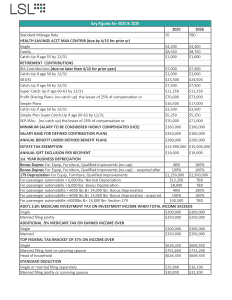As more Americans are facing their retirement years, many people are a-buzz over Roth accounts. The beauty of all retirement accounts is that your earnings grow tax free until you withdraw the funds in retirement. The uniqueness of the Roth option is that those earnings will not be taxed upon withdrawal. However, to get this tax-free withdrawal of a Roth, you give up the tax deduction of the initial contribution in the earlier/current year.
Roth accounts are not subject to required minimum distributions (RMDs), so you can use them to control your taxation during retirement years.
Upon inheriting a Roth account, beneficiaries will need to empty the account within 10 years of the owner’s death, just as with regular retirement accounts. Those distributions will not be taxable to the beneficiary.
To withdraw the growth in your Roth accounts tax-free, you cannot withdraw before age 59½ and must have had five years pass from first funding of any Roth account, or from each Roth conversion made. You can withdraw your principal (contributions) at any time without tax or penalty. Note: Withdrawing Roth earnings before age 59½ will usually trigger a 10% early withdrawal penalty.
How to Fund a Roth
In recent years, the government has provided taxpayers with more access to Roth accounts than in the past. Here are some ways that you can fund a Roth account:
- Direct Roth IRA – For 2024 a direct Roth IRA contribution of up to $7000 ($8000 if age 50 by end of year) is allowable for those with modified AGI (Adjusted Gross Income) under $161,000 for single filers and $240,000 for married filing joint filers. The contribution is limited to earned income, so if your taxable wages are only $3000 for the year, your Roth IRA contribution would be limited to $3000. Funding a child’s Roth when they get some earnings from their first job at In-N- Out Burger is a great way to use compounding growth for a nice nest-egg in their future.
- Backdoor Roth – If your income is too high to contribute directly to a Roth IRA, you can use the Backdoor Roth In this instance, you can make a non-deductible IRA contribution and convert it to a Roth before any earnings cause the account to grow. NOTE: This conversion can be tax-free if you have no other “previously deducted” IRA balances. (Remember, IRA stands for Individual Retirement Account, meaning a spouse’s retirement account will not count against the other spouse.)
Otherwise, the taxation of the conversion to Roth is calculated using the percentage of non-deductible basis over the total amount of IRA balances linked to that taxpayer’s Social Security number. Note that “inherited IRAs” will not be counted in the denominator of that percentage and will not cause taxation of a Roth conversion.
- Company 401k plan – Most company retirement plans now allow employees to choose their 401k elective contribution to be a Roth. The employee must be reminded that they lose the tax deduction when they designate these contributions as Roth.
The allowable 2024 401(k) amount is $23,000, with a “catch-up” amount of $7,500 if you reach age 50 by the end of the year. (So, you can contribute $30,500 to your Roth if you’re 50 years old by 12/31/24).
Surprisingly, the IRS allows you to max both your Roth 401k contributions and an outside Roth contribution, if your income is low enough to qualify for the outside, direct Roth contribution.
- The Mega Backdoor Roth –The “Mega” backdoor Roth got its name from the higher limits that can be contributed to a Roth account. In fact, you can contribute as much as $46,000 for 2024. However, higher numbers mean more complications and rules, and this method is best suited to owners of businesses who don’t non-highly compensated employees because it causes the plan to be top-heavy, requiring larger contributions for those employees.
Below are some more details of the Mega Backdoor Roth.
Mega Backdoor Roth Details– It is imperative that retirement plan administrators assist with the planning, required documentation, and execution of the Mega Backdoor Roth. Here are some guidelines, but it is imperative that you seek the guidance of your plan administrator.
- You must max out your employee elective 401(k) contributions from your payroll.
- Whatever you contribute here will reduce the amount you can contribute to your Profit Sharing Plan.
- The Mega Backdoor Roth may be best suited for those who also contribute to a Defined Benefit Plan because they already have very large tax deductible contributions and may not mind losing the tax-deductible Profit Sharing contributions.
Note: Many employees contribute some tax-deductible contributions to the Profit Sharing Plan and some to the Mega Backdoor Roth.
- Please remember: Your retirement plan document must allow for after-tax contributions and in-service withdrawals to a Roth IRA or transfers to a Roth 401(k). You must make sure that the plan allows you to leave the pre-tax portions in the regular 401(k) account to ensure that none of this is taxable upon conversion.
- You will use your personal, after-tax dollars to contribute to the company retirement plan, and the conversion to Roth will happen inside the company plan.
Conclusion
Having sources of tax-free income in your retirement years makes a lot of sense. Still, the future benefits need to be weighed against the current loss of your otherwise tax-deductible contributions. The cashflow of a tax deduction today could be invested and grown on its own. If you think you will spend everything that comes in to your household, rather than investing the tax savings, then forcing yourself to pay the tax now with a Roth option may make the best sense for you. Carefully analyze your options and consult your investment advisor, retirement plan provider, and CPA.
Please feel free to reach out to your LSL professional for guidance in your particular situation.




